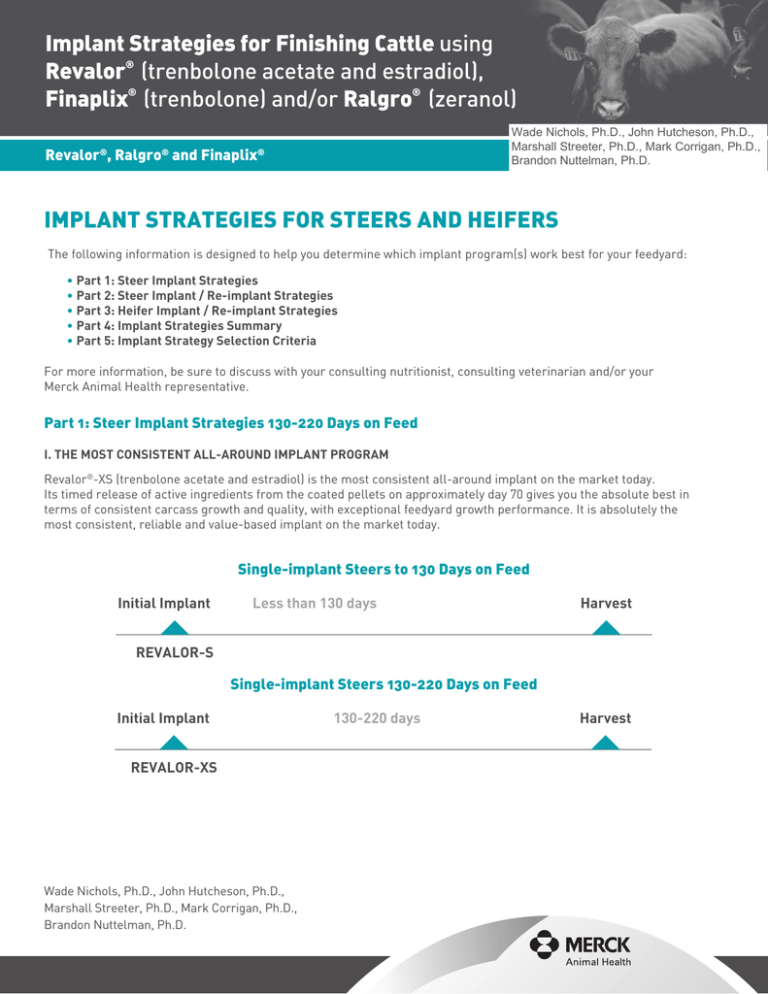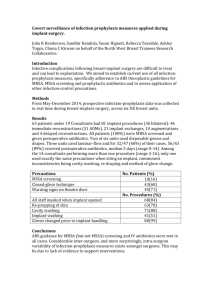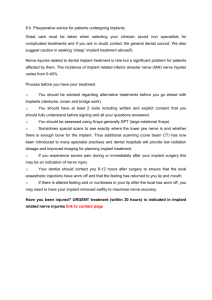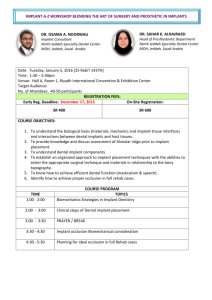
Implant Strategies for Finishing Cattle using
Revalor® (trenbolone acetate and estradiol),
Finaplix® (trenbolone) and/or Ralgro® (zeranol)
Wade Nichols, Ph.D., John Hutcheson, Ph.D.,
Marshall Streeter, Ph.D., Mark Corrigan, Ph.D.,
Brandon Nuttelman, Ph.D.
Revalor , Ralgro and Finaplix
®
®
®
IMPLANT STRATEGIES FOR STEERS AND HEIFERS
The following information is designed to help you determine which implant program(s) work best for your feedyard:
• Part 1: Steer Implant Strategies
• Part 2: Steer Implant / Re-implant Strategies
• Part 3: Heifer Implant / Re-implant Strategies
• Part 4: Implant Strategies Summary
• Part 5: Implant Strategy Selection Criteria
For more information, be sure to discuss with your consulting nutritionist, consulting veterinarian and/or your
Merck Animal Health representative.
Part 1: Steer Implant Strategies 130-220 Days on Feed
I. THE MOST CONSISTENT ALL-AROUND IMPLANT PROGRAM
Revalor®-XS (trenbolone acetate and estradiol) is the most consistent all-around implant on the market today.
Its timed release of active ingredients from the coated pellets on approximately day 70 gives you the absolute best in
terms of consistent carcass growth and quality, with exceptional feedyard growth performance. It is absolutely the
most consistent, reliable and value-based implant on the market today.
Initial Implant
Initial Implant
REVALOR-S
Less than 130 Steers
days to 130 Days on Feed
Single-implant
Less than 130 days
Harvest
Harvest
REVALOR-S
Single-implant Steers 130-220 Days on Feed
Initial Implant
130-220 days
Harvest
Initial Implant
REVALOR-XS
130-220 days
Harvest
REVALOR-XS
Wade Nichols, Ph.D., John Hutcheson, Ph.D.,
Marshall Streeter, Ph.D., Mark Corrigan, Ph.D.,
Brandon Nuttelman, Ph.D.
Implant Strategies for Finishing Cattle
Payout Data: Payout characteristics versus non-implanted steers with a single Revalor-S implant.
Serum Concentration, pg/mL
Revalor-S Payout
75
70
65
60
55
50
45
40
35
30
25
20
15
10
5
0
Single Revalor-S Implant
0
50
100
150
200
250
Days After Implantation
Period Gain Data
Average Daily Gain (ADG) period response versus
non-implanted steers with a single Revalor-S implant.
Period
Daily Gain Response
0-35 days
+28%
35-70 days
+23%
70-105 days
+17%
105-135 days
+10%
Rains, J.R., R.L. Preston, Revalor-S Tech Bulletin 10
300
Payout Data: Payout characteristics comparing non-implanted steers with a single Revalor-S or
Revalor-S initial with a re-implant on day 70.
Serum Concentration, pg/mL
Re-implant with Revalor-S Payout
75
70
65
60
55
50
45
40
35
30
25
20
15
10
5
0
Re-implant with Revalor-S
on Day 70
Single Revalor-S Implant
0
50
100
150
200
250
Days After Implantation
Period Gain Response
Average Daily Gain (ADG) period response versus
non-implanted steers with a single Revalor-S or
Revalor-S initial with a re-implant on day 70.
Period
Daily Gain Response
0-35 days
+28%
35-70 days
+23%
70-105 days
+30%
105-135 days
+32%
Rains, J.R., R.L. Preston, Revalor-S Tech Bulletin 10
300
Implant Strategies for Finishing Cattle
Payout Data: Theoretical payout characteristics of non-implanted steers compared with
a single Revalor-S or Revalor-XS.
Serum Concentration, pg/mL
Revalor-XS Payout
75
70
65
60
55
50
45
40
35
30
25
20
15
10
5
0
Revalor-XS
Single Revalor-S Implant
0
50
100
150
200
250
Days After Implantation
Period Data
Average Daily Gain (ADG) period response versus
non-implanted steers compared with Revalor-XS.
Period
Daily Gain Response
0-35 days
+28%
35-75 days
+18%
75-140 days
+30%
140-177 days
+27%
2009 Feedyard Study Data on File
300
Part 2: Steer Implant / Re-implant Strategies
I. ALL-AROUND RE-IMPLANT PROGRAM
Excellent performance in terms of ADG and feed efficiency (F:G). Minimal to no quality grade reduction as long as cattle
are finished to their physiological/biological end-points.
Single-implant Steers to 130 Days on Feed
Initial Implant
Less than 130 days
Harvest
Initial Implant
Less than 130 days
Harvest
REVALOR-S
Initial
Implant
Less than 130 days
Harvest
REVALOR-S
Initial
Implant
Less than 130 days
Harvest
REVALOR-S
REVALOR-S
Initial Implant
Single Implant Steers 130-220 Days on Feed
130-220 days
Harvest
Initial Implant
130-220 days
Harvest
REVALOR-XS
Initial
Implant
130-220 days
Harvest
REVALOR-XS
Initial
Implant
130-220 days
Harvest
Harvest
Initial Implant
50-120 days
Re-implant
80-100 days
Re-implant
130-220 Days
on Feed
50-120
days Steers
Re-implant
80-100
days
REVALOR-IS
Initial
Implant
50-120 days
REVALOR-S
Re-implant
80-100 days
Harvest
REVALOR-IS
Initial
Implant
50-120 days
REVALOR-S
Re-implant
80-100 days
Harvest
130-220 days
Harvest
REVALOR-XS
REVALOR-XS
Initial Implant
REVALOR-IS
REVALOR-S
REVALOR-IS
REVALOR-S
Initial Implant
90-120 days
Re-implant
Initial Implant
Harvest
90-120 days
130-220 days
Re-implant
Single
Re-implant
Steers
220-340
Days on Feed
REVALOR-IS
REVALOR-XS
Initial
Implant
90-120 days
130-220 days
Re-implant
Harvest
REVALOR-IS
Initial
Implant
Harvest
90-120 days
REVALOR-XS
Re-implant
REVALOR-IS
REVALOR-XS
REVALOR-IS
REVALOR-XS
130-220 days
Harvest
Implant Strategies for Finishing Cattle
Initial Implant
Less than 130 days
Harvest
Initial Implant
Less than 130 days
Harvest
REVALOR-200
II. SPECIAL-PERFORMANCE-BASED
RE-IMPLANT PROGRAM
REVALOR-200
Superior performance in terms of ADG and F:G is the main goal. Heavier weights will need to be achieved to minimize
grade reduction.
Initial Implant
60-110
days
Re-implant
70-120
days
Single-implant
Steers
to 130 Days
on Feed
60-110 days
Re-implant
Initial Implant
Initial Implant
Less than 130 days
REVALOR-S
REVALOR-S
REVALOR-S
REVALOR-200
70-120 days
Harvest
Harvest
Harvest
REVALOR-S
Re-implant
Steers
130-220
Days on Feed,80-100
Performance-Based
Initial Implant
Harvest
50-120
days
Re-implant
days
Initial Implant
Initial
Implant
REVALOR-IS
50-120 days
60-110 days
Re-implant
Re-implant
REVALOR-200
80-100 days
70-120 days
Harvest
Harvest
REVALOR-200
REVALOR-S
REVALOR-IS
REVALOR-S
Re-implant Steers 220-340 Days on Feed
Initial Implant
140-220 days
Re-implant
80-120 days
Harvest
Initial Implant
50-120 days
140-220
days
Re-implant
80-100 days
80-120
Harvest
80-120 days
Harvest
REVALOR-XS
REVALOR-200
REVALOR-IS
REVALOR-XS
REVALOR-200
Initial Implant
REVALOR-XS
140-220 days
Re-implant
REVALOR-200
Part 3: Heifer Implant/Re-implant Strategies
I. ALL-AROUND RE-IMPLANT PROGRAM
Excellent performance in terms of ADG and feed efficiency (F:G). Minimal to no quality grade reduction as long as cattle
are finished to their physiological/biological end-points.
Initial Implant
Initial Implant
Initial Implant
REVALOR-H
REVALOR-H
REVALOR-H
Single-implant Heifers to 130 Days on Feed
Less than 130 days
Less than 130 days
Less than 130 days
Harvest
Harvest
Harvest
Re-implant Heifers 130-220 Days on Feed
Initial Implant
Initial Implant
Initial Implant
REVALOR-IH
REVALOR-IH
REVALOR-IH
Harvest
Re-implant
80-100 days
Harvest
Re-implant
80-100 days
Harvest
Re-implant
80-100 days
REVALOR-H
or
REVALOR-H
FINAPLIX-H
(trenbolone
acetate)*
or
REVALOR-H
FINAPLIX-H (trenbolone
acetate)*
or
FINAPLIX-H
(trenbolone
acetate)* 80-120 days
60-100
days
80-120
days
Re-implant Heifers 220-340 Days on Feed
Initial Implant60-100 daysRe-implant80-120 daysRe-implant80-120 days Harvest
Initial Implant60-100 daysRe-implant80-120 daysRe-implant80-120 days Harvest
Initial Implant
Re-implant
Re-implant
Harvest
REVALOR-IH
REVALOR-H
RALGRO
or
RALGRO
REVALOR-IH
REVALOR-H
*
FINAPLIX-H
or
REVALOR-H
REVALOR-IH
RALGRO
*
FINAPLIX-H
or
FINAPLIX-H*
50-120 days
50-120 days
50-120 days
Finaplix-H can be used when the terminal implant period is ≤ 100 days.
*
II. SPECIAL-PERFORMANCE-BASED RE-IMPLANT PROGRAM
Superior performance in terms of ADG and F:G is the main goal. Heavier weights will need to be achieved to minimize
grade reduction.
Single-implant Heifers to 130 Days on Feed
Initial Implant
REVALOR-200
Less than 130 days
Harvest
Initial Implant
80-130 days
Harvest
Implant Strategies for Finishing Cattle
REVALOR-200
Re-implant Heifers 130-220 Days on Feed
Initial Implant
50-90 days
50-120
days
Re-implant
90-120
80-100 days
Harvest
REVALOR-200
REVALOR-H
REVALOR-IH
Re-implant Heifers 220-340 Days on Feed
50-90 days
80-120 days
90-130 days
Initial Implant
Harvest
Re-implant
Re-implant
REVALOR-IH
REVALOR-H
REVALOR-200
Part 4: Implant Strategies Summary
Recommended Days on Implant for Steers and Heifers
Implant
Minimum
Ideal Range
Maximum
Revalor-XS
130
130-210
220
Revalor-S
70
80-120
130
Revalor-IS
50
70-90
120
Revalor-H
70
80-120
130
Revalor-IH
50
70-90
120
Revalor-200
70
80-120
140
Finaplix-H
50
60-90
100
Ralgro
30
60-90
100
Initial
Re-implant Day
Terminal
130 or less
Revalor-S
None
None
131-170
Revalor-XS
None
None
171-180
Revalor-XS
None
None
181-190
Revalor-XS
None
None
191-210
Revalor-XS
None
None
211-220
Revalor-XS
None
None
EXAMPLE: Steer Single Implant Strategies
Days on feed
EXAMPLE: Steer All-around Re-implanting Strategies
Steers Re-implant Strategies
Days on feed
Initial
Re-implant Day
Terminal
130 or less
Revalor-S
N/A
N/A
131-150
Revalor-IS
Day 50
Revalor-S
151-170
Revalor-IS
Day 70
Revalor-S
171-190
Revalor-IS
Day 90
Revalor-S
191-200
Revalor-IS
Day 100
Revalor-S
201-220
Revalor-IS
Day 120
Revalor-S
Initial
Re-implant Day
Terminal Intermediate
221-240
Revalor-IS
Day 90
Revalor-XS
241-260
Revalor-IS
Day 110
Revalor-XS
261-340
Revalor-IS
Day 120
Revalor-XS
Days on feed
EXAMPLE: Heifer Performance-Based Re-Implant Strategies
Days on feed
Initial
Re-implant Day
Terminal*
130 or less
Revalor-200
N/A
N/A
131-140
Revalor-IH
Day 50
Revalor-200
141-150
Revalor-IH
Day 60
Revalor-200
151-160
Revalor-IH
Day 70
Revalor-200
161-170
Revalor-IH
Day 70
Revalor-200
171-180
Revalor-IH
Day 80
Revalor-200
181-190
Revalor-IH
Day 90
Revalor-200
191-210
Revalor-IH
Day 100
Revalor-200
211-220
Revalor-IH
Day 120
Revalor-200
Days on feed
Initial
Re-implant Day
Intermediate
Re-implant Day
Terminal*
221-240
Revalor-IH
Day 50
Revalor-H
Day 130
Revalor-200
241-280
Revalor-IH
Day 70
Revalor-H
Day 170
Revalor-200
281-340
Revalor-IH
Day 90
Revalor-H
Day 210
Revalor-200
Finaplix-H can be used when the terminal implant period is ≤ 100 days.
*
Implant Strategies for Finishing Cattle
Part 5: Implant Strategy Selection Criteria
All the above implant strategies give you some leeway in marketing cattle. As an example: For those who do not want
to re-implant their steers, Revalor-XS provides the greatest marketing flexibility and for those wanting to re-implant
a terminal, Revalor-S is mostly utilized 100 days from harvest. This gives you the ability to market cattle earlier than
expected and longer than expected, i.e. 170-day cattle can be marketed at 150 or 200 days. There are some trade-offs that
we need to be aware of. For example, 150-day cattle will have better ADG and F:G simply because we are selling them
somewhat green, the 200-day cattle will have more marbling, maybe higher dressing percentage, more weight, and less
ADG and F:G simply because we are selling them over-finished.
During times of low ration costs and fair live cattle prices, we can keep cattle on feed longer and cost of gain rarely
exceeds breakeven. We can be performance-based in our feeding and cattle management as well as our implant
programs. Conversely, when ration costs become expensive and live cattle prices are low, we will adjust the implant
strategies to finish cattle at lighter weights and less time on feed (figure 1).
The spread between choice and select carcasses becomes of interest when the difference in dollars/cwt is substantial.
It should also be considered when selling on a grid that pays a premium for marbling. However, finishing cattle to the
correct weight will usually negate any marbling differences. As an example, figure 1 depicts low feed-low spread, which
would indicate that we would want to feed for average grading and maximum weight. We can use performance-based
implant strategy in this economic example. Feeding heavier weights takes advantage of the low feed costs and the heavier
weights will help negate any negative marbling effects.
Do not just look at days on feed to determine when cattle are ready for harvest. Let the cattle tell you when they are
finished. Look at the cattle’s body composition and feed records, since not all 700-weight animals are the same. Adjust
days on feed based on animal type, body conformation, and body composition. In addition, analyze carcass data to see if
the cattle are achieving the correct end-points of production. If the closeouts have virtually all yield grade (YG) 1s and
2s with very little YG 3s and no 4s, then in general, the cattle are too light or green to achieve their genetic potential to
marble. The cattle need a percentage of YG 3s to allow them to achieve their genetic potential to marble (on the average),
as well as reach a final end weight that allows the cattle to work both from a carcass perspective and a live perspective.
Figure 2 illustrates, as an example, cattle implanted differently and the final end weights needed to achieve an empty body
fat (EBF) percentage of 28.6% (Guiroy, et al. 2002, Journal of Animal Science 80:1791-1800). Research has indicated that an
EBF of 28.6% is required for cattle to reach low choice marbling. Implanting changes the growth curve upward to a higher
level. In other words, when we implant cattle that are a frame score 5, we now change their growth to mimic a frame score
6-7 (figure 3). These cattle will now need to be heavier to reach their genetic physiological/biological maturity.
Figure 4 depicts the amount of EBF needed for cattle to grade standard, select, low-choice or mid-choice. On average, if
we sell cattle that have less than 28% EBF, they will not exhibit enough finish to reach a USDA quality grade of low-choice.
The majority of cattle need to have 28.5-29.5% EBF in order to grade to their genetic potential.
Therefore, all these factors need to be taken into consideration when choosing an effective implant strategy, i.e.
feed costs, animal costs, quality grade, genetics, economic advantages of weight (live & carcass), production goals
and carcass goals. There are trade-offs to all the above. Implants can help you achieve your goals and benefit you
economically in all circumstances.
Figure 1: A grid utilizing feed costs and choice/select spread for implant decisions.
Cattle Selection
Maximum Grading
- Maximum weight
- Implant cattle type depend
High Feed - High Spread
Average Grading
- Maximum weight
- Maximum implant
High Feed - Low Spread
Average Grading
- Maximum YG
- Maximum weight
- Maximum implant
Low Feed - High Spread
Buy for Growth
Low Feed - Low Spread
- Maximum performance
- Maximum implant
• Adapted from schematic developed by M. Hubbert, Ganado Research, Arroyo Seco, NM
• Feed = Feed costs either high or low
• Spread = Dollars/cwt difference between choice and select carcasses
Figure 2: Growth curve graph depicting finished weights of cattle that are implanted differently.
Implants Change the Growth Curve
40
35
Empty Body Fat, %
30
28.6% EBF
Low Choice
25
20
15
No Implant*
10
1 Implant
5
2 Implants
or Revalor-XS**
0
800
1100
1165
1230
1265
Finish Weight (lb)
* Based on Guiroy, et al. 2002, Journal of Animal Science 80:1791-1800
** Based on Revalor-XS Serial Harvest Study
Implant Strategies for Finishing Cattle
Figure 3: This table illustrates the finishing weight by frame score relationship
for an animal to reach 28% empty body fat.
Weight (lb) at 28% fat
Frame size
1
2
3
4
5
6
7
8
9
Steer
882
954
1029
1102
1175
1250
1322
1395
1470
Heifer
705
763
824
882
939
1001
1058
1115
1177
Figure 4. Graph depicting amount of EBF needed to reach a particluar USDA quality grade
(Guiroy et al. 2001, Journal of Animal Science 79: 1983-1995).
Relationship of empty body fat to
Quality Grade (total of 1,355 animals)
34
Empty Body Fat, %
32
30
Mid Choice, 29.9% EBF
Low Choice, 28.6% EBF
28
Select, 26.2% EBF
26
24
22
Standard, 21.1% EBF
20
3 3.5
4
4.5
5
5.5
6
6.5
7
7.5
8
8.5
9
9.5 10
Quality Grade
A withdrawal period has not been established for Ralgro, Revalor and Finaplix in pre-ruminating calves. Do not use in
calves to be processed for veal. For complete information, refer to product label.
Wade Nichols, Ph.D., John Hutcheson, Ph.D., Marshall Streeter, Ph.D.,
Mark Corrigan, Ph.D., Brandon Nuttelman, Ph.D.
merck-animal-health-usa.com • 800-521-5767
Copyright © 2015 Intervet Inc., doing business as Merck Animal Health, a subsidiary of
Merck & Co., Inc. All rights reserved.
6/15 BV-53092-Finishing







